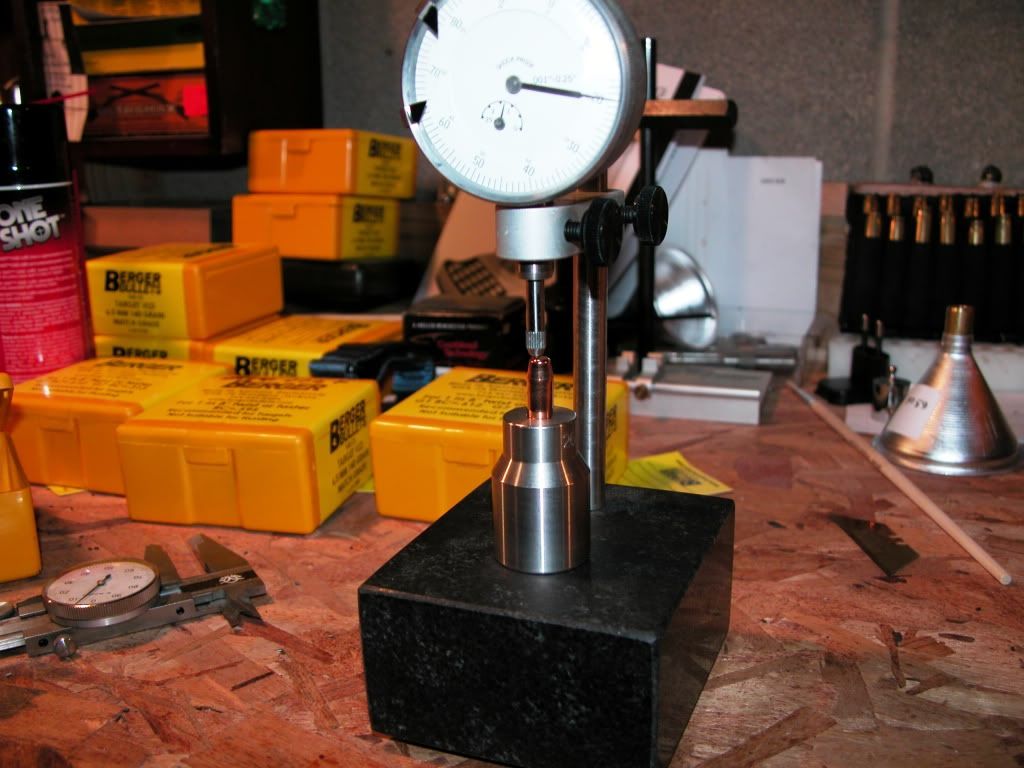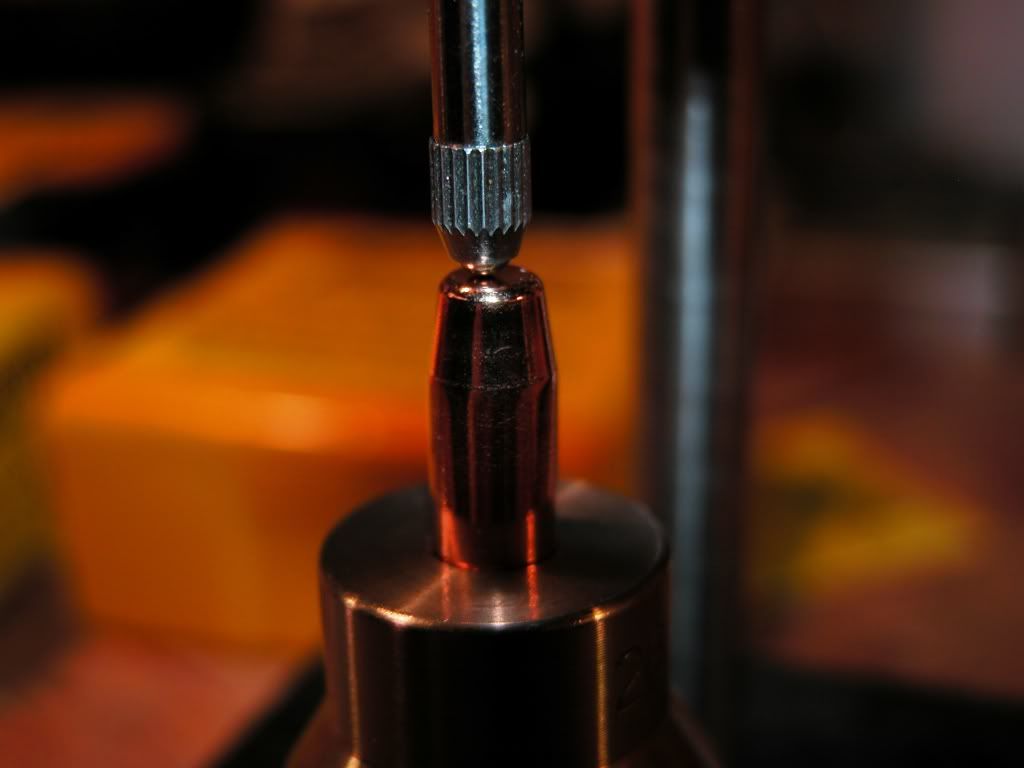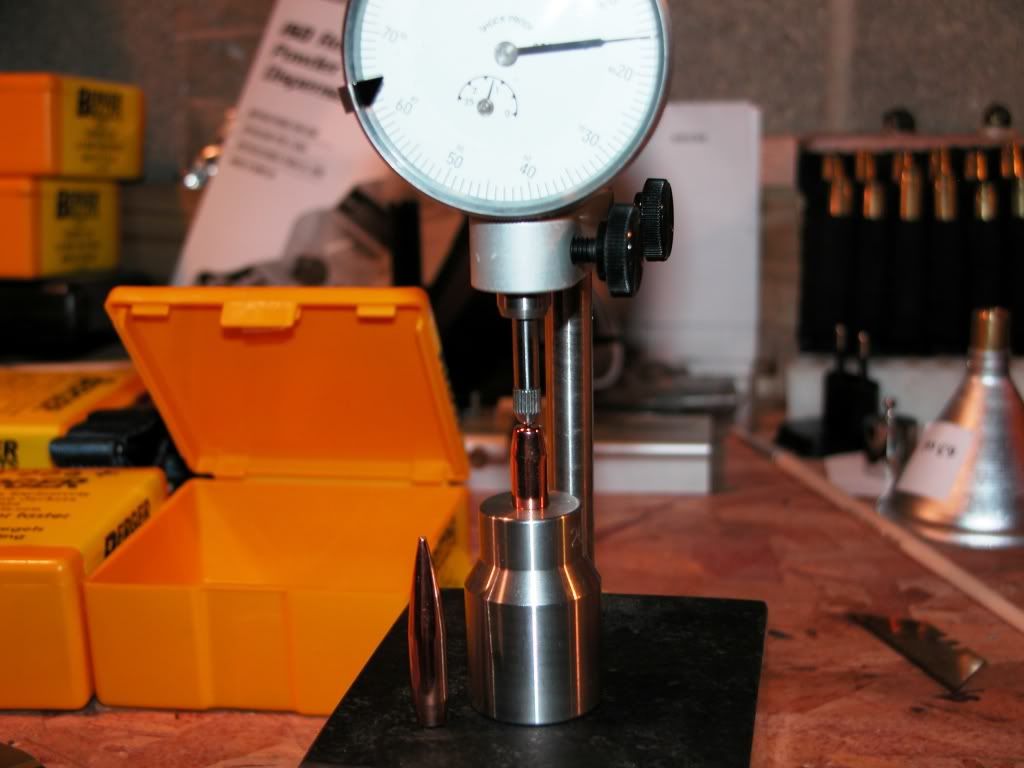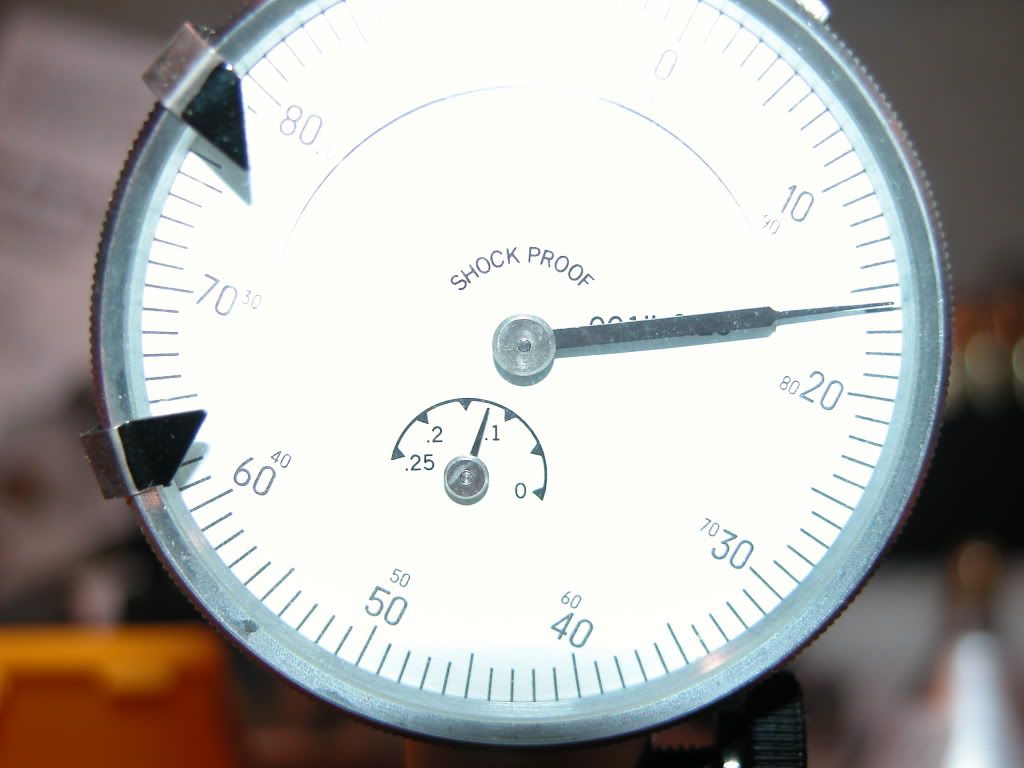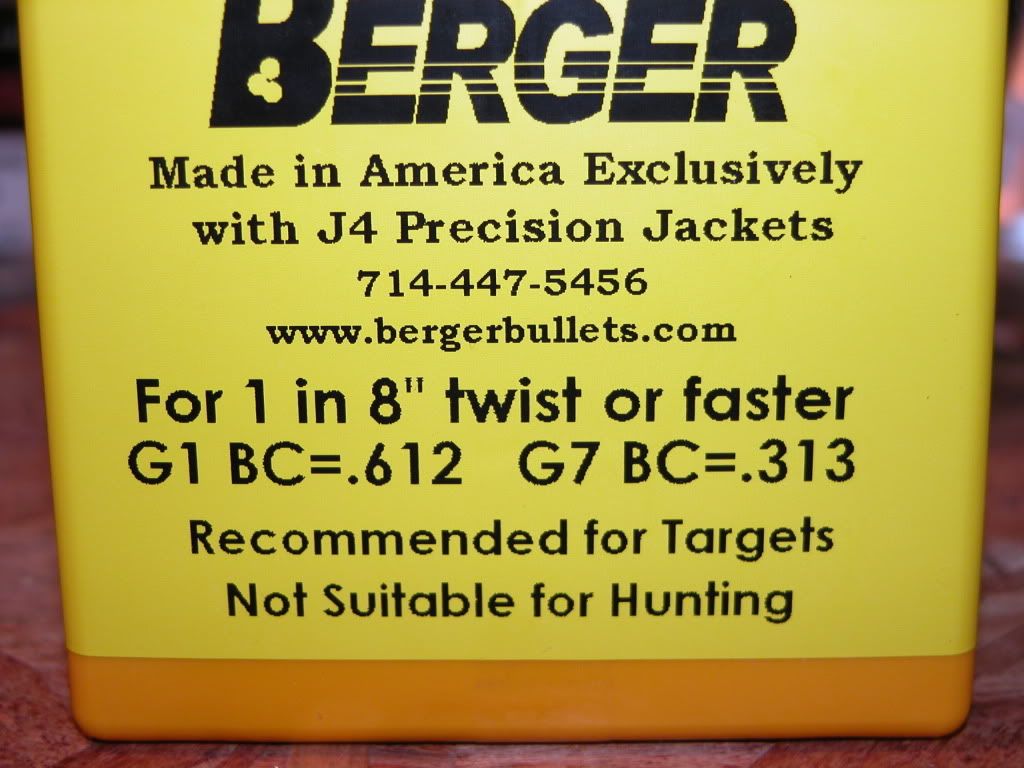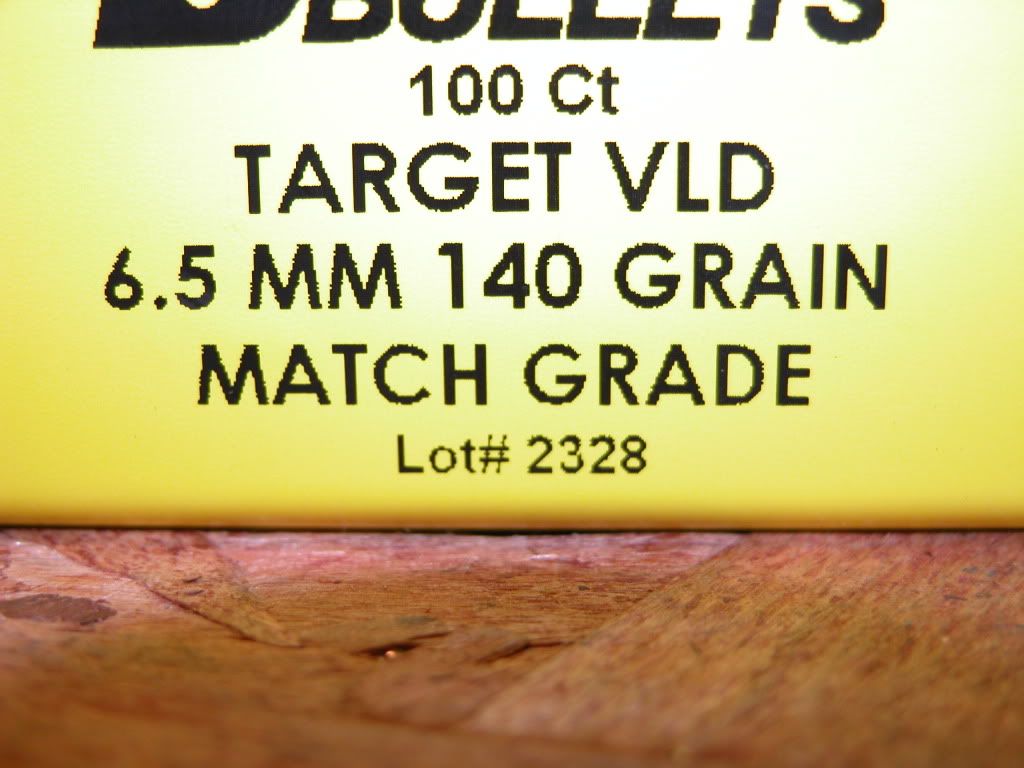<span style="font-weight: bold">Chapter 2: How to prepare a bullet for a long journey.
</span>
So we got our cases prepped and primed in Ch. 1. Now let's look at our bullets.
In our chase for consistency obviously our bullets have to all be IDENTICAL if they are going to launch and fly the same, shot to shot. I have and will continue to say this a lot: Where chasing consistency, in EVERYTHING.
<span style="font-style: italic">Before I get going...let me say this! If you ever, might, possibly, once-in-a-life- time shoot past 600 yards- you guys shooting .308" diameter bullets do not waste your time, money & barrel life on working up loads with 168 grain bullets! Start with 175's or heavier. If you like, experiment with 155’s, but SKIP 168’s. Thanks, I feel better. The 168 grain bullet to beginner .308 shooters is what the 9x19mm Parabellum pistol round is to Hollywood- you'd think it would kill a polar bear instantly if he were to be shot in the paw with it. It's a cliche, it's not the best long range bullet! It in fact may be THE lowest on the list.</span>
So according to our cartridge and advice given we have picked a bullet or two to try in our long range weapon. So let's learn a few basic generalized bullet terms:
Meplat = the point(ed end of the bullet)
Ogive ["oh jive"]= the curved radius leading from the bearing surface to the meplat.
Bearing Surface= the actual main diameter of the bullet that actually engages/touches the barrel on it's journey to the muzzle and beyond.
Base = the butt or base of the bullet, opposite the meplat.
So let’s get out our box of 100 bullet’s, or even better our 500+ bulk box.
Our bullets need to be as microscopically identical to each other as possible. So we are going to discuss the various measurements and inspections to ensure this, as well as how we can tune up our bullets a little bit.
The first two steps are generally spot on in high quality match grade bullets. So believe it or not we’re gonna give a little room for assumption in these first two measurements. We’ll do a quick check and give our bullets the nod if a few look on the up & up.
First!
Let’s measure the diameter of about a dozen randomly picked bullets. If you do not have a micrometer, just skip right over this first step. Some people will surely chuckle at my suggesting to measure the diameter. I’m not suggesting that the bullets will be so far out of spec as to be dangerous etc. But in the theme that “1000 yards is BRUTAL” we want to rule out any and everything that may cause Inconsistency. Also, I’m a machinist and accustomed to measuring things in extremely fine graduations. I have had to work contracts in the past that required measurements in the fifty-millionth’s of one inch. 99% of guys will grab something and measure it’s dia in one place. But a true diameter measurement in done several places along the length, along it’s axis (“Axially”) as wells several places around it. (“Radially”) (measure it, rotate it a little measure again) No I have never had a problem with Green or Yellow box bullets varying in diameter, but I have had a certain popular color box of bullets be egg shaped! Measuring radially will let you know if the part is really round or not. For the record I doubt if a bullet being egg shaped by .0001 or .0002” (two ten-thousandth’s of 1 inch) will affect accuracy as the bullet will engrave to the barrel and is in a plastic state while it’s in the tube so the barrel will reform the bullet to a more round state. But I personally am anal about all this stuff and error on the side of overkill. Egg shaped bullets do not instill confidence! But again if you do not have a good micrometer- don’t sweat this first test- I have NEVER found diameter problems with ANY bullet that came out of a Green or Yellow box.
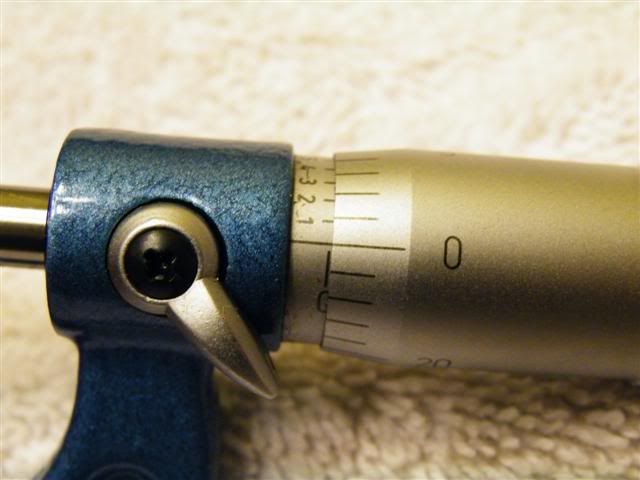
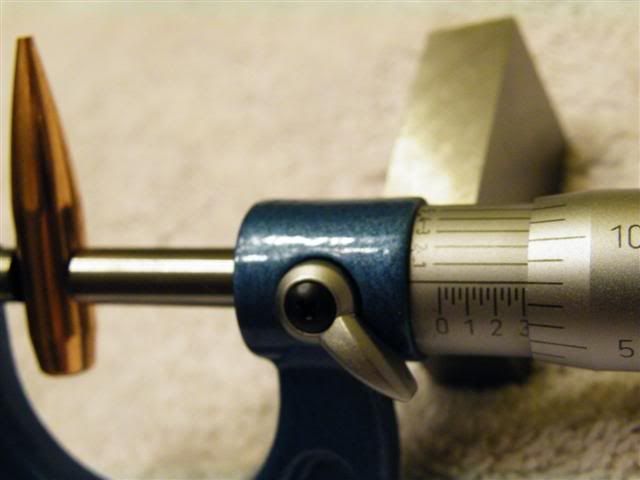
Second:
Now for another abbreviated test. This is probably only worthwhile if you have a very fine set of mechanical balance type scales or digital scales. Let’s weight 25 or so and make sure the weight is running pretty much spot on. I have never had much of an issue with weight variation in bullets coming out of a Yellow or Green box though I will say on semi-frequent occasion you will get some out of tolerance when working through a box. So as long as a small test batch looks good, we’ll assume the lot is fine unless you deem your time, and rifles potential worth splitting hairs. If so, weigh EVERY bullet and sort them in .2 grain (or finer) lots
Third:
Now we move to a critical test. Evidently this spec is far harder for the manufacturers to hold than weight or diameter. We’re going to measure the length of the bearing surface of the bullet. The bearing surface is the only part of the bullet that touches the bore/rifling. Let say we have a standard bearing surface length of (.500”) a half inch for the sake of round numbers. Great. But if a bullet shows up with .490” bearing surface, - .010” (10 thousandth’s) short of standard We know it will not have as much surface rubbing the bore, which will not cause as much pressure build up so that bullet will achieve a lower muzzle velocity and it will impact low. Ah ha! Now we are learning.
And the same can be said if a bullet shows up with a .510 bearing surface or +.010” longer than standard.. We know it has a little more surface area contacting our bore, which equates to more resistance, which equates higher pressure and more velocity. Yep, you guessed it- this bullet will achieve higher MV and it will impact high. So let’s make a pact we are going to sort our bullets into groups of bearing surface lengths so that when we shoot long range we are all smiles, deal?
How do we measure bearing surface lengths? Glad you asked! There are several ways, but since we most likely already have a set of dial/digital calipers, let’s just got that route. It’s a little cheaper too. Hopefully by now you have received in the mail your bump gauge attachment for your calipers that we spoke of in Chapter One: Brass Prep. But let’s revisit the tool because we’re gonna need an additional one as well as two inserts.
Tool list:
You’ll need two of these to measure the bearing surface of your bullet. (or one if you already have one for measuring you case headspace/bump length as spoke of in Chapter One: Case Prep.
http://www.sinclairintl.com/product/5574/Bullet-Comparators
And you’ll need two of these. They are bullet caliber/diameter specific!
http://www.sinclairintl.com/product/11173/Bullet-Comparators
So to measure the length of the bearing surface, we insert the bullet comparator inserts into the bodies and just slightly snug the set screw. Now place a body onto each jaw of the calipers and snug the thumbscrew. Make sure the comparator inserts are lined up with each other as closely as you possibly can. Do this by feel dragging a finger across from the end of one to the start of the other.
Now with the comparators gently slid together Zero your calipers. Take a couple of dozen or so bullets and measure the bearing length. Write down the most consistent reading of the bunch and call this the measurement “they are supposed to be.” I get several containers and place a yellow sticky note on them. This one we’ll call “nominal” or “supposed to be.” But then we need a
-.002” (minus two thousandths) container, a -.004” and God forbid there be a need for a -.006” container. Do this with + (positive) +2 +,4, & + ? thousandths as well. It’s okay that not all the bullets are exactly the same as far as the whole batch goes. We just want to have a, specific bearing length per trip in the field/range/match so they all have as near identical MV as possible.
In this next picture are my two bodies (holders) two 30 cal bullet comparator inserts and in the center is my headspace/bump gauge which is used to measure from the head of the case to the datum of the shoulder- See Chapter One: Brass Prep
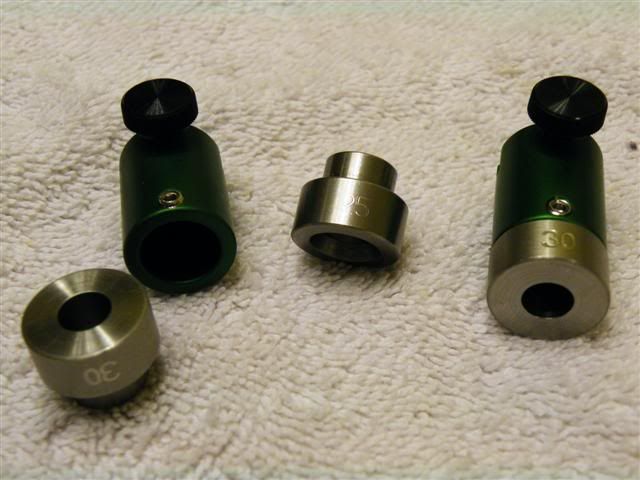
Next we have the comparators installed and aligned on the caliper jaws in the picture below:
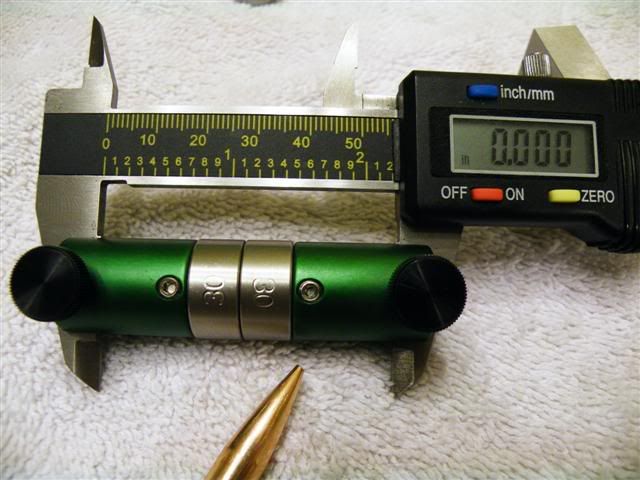
and finally the bearing surface actually being measured (below)
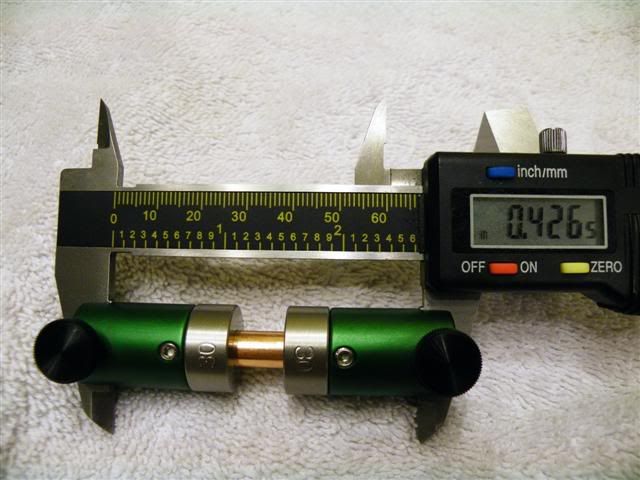
Fourth:
About those Meplats. What is “Meplat”? It is the present tense act of a person platting or braiding a three-fold cord. Just kidding. We already learned the meplat is essentially the point of the bullet. So why are we concerned with them? Consistency of course. Dumb question. WE ARE FOREVER CHASING CONSISTENCY. Not all Meplats are created equal. And considering the bullets come out of my 300 Win mag with a 10 twist barrel @ just over 2900 fps- they are doing in the neighborhood of 211,000 rpms if my math is correct. (No guarantees there!)
So if you go through your box of match bullets, you’ll quickly see many many bullets have OBVIOUSLY inconsistent meplats. Well we cannot have inconsistency & happy shooting on the same short bus. They just can’t be found in the same places. Enter the meplat trimmer.
A Meplat trimmer is a simple tool that too can be had from Sinclair int. & similar companies. It uses a endmill to trim back the meplat to the point that it’s cleaned up/consistent. And when we run all our bullets through the trimmer, their all have exactly the same Meplat diameter and are square to the bullet.
True, a meplat trimmer blunts the bullet a teeny bit, and that does make it a bit dirtier. (“dirty” being a slang aeronautical term that means NOT aerodynamic) yes it reduces BC, but the
BC were not consistent with all those gimped up bullet points anyway.. So take your pick. Have an inconsistent/untrue but published high BC , or have a bit lower BC but it’s dead on consistent bullet to bullet, shot to shot at range. For you anal types like me that have to have a number-, I keep hearing a 2% quote- that is trimming the meplat reduces BC by 2%.
Here’s a picture of a gimped up point, and the same after trimmed.
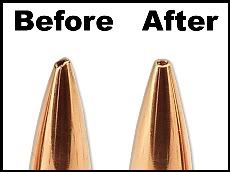
Here’s Sinclairs link to their trimmer
http://www.sinclairintl.com/product/11233/s
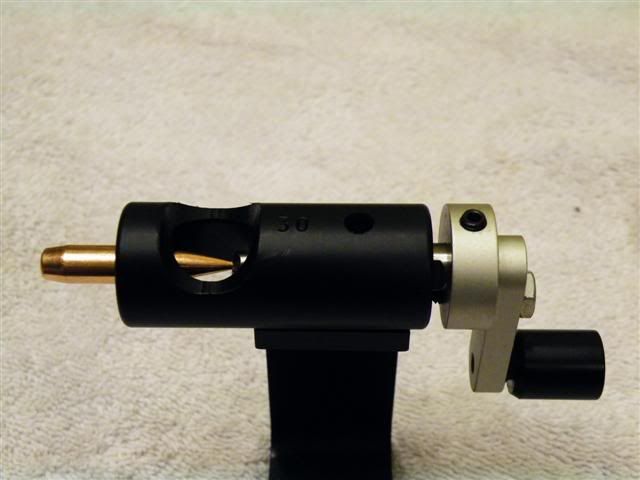
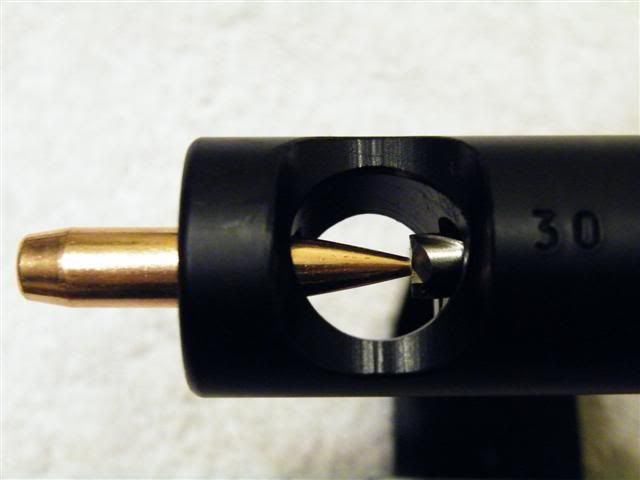
Fifth:
Bullet “Pointing”
NRA competitor Robert Whidden developed a die system that presses a keener point on a given hollow point match bullet. This increases BC which allows the bullet to retain velocity, energy and wind bucking ability better. Most of us on this website are shooting 6.5mm and bigger bullets. My understanding is bullet “pointing” has great gains in .224 bullets as well as good gains in 6mm, but the larger diameter the bullet the more negligible the return. I’ll let you read about it here, http://www.whiddengunworks.net/pointingdie.html because man I am I tired of typing!
So this concludes how to sort and prep your bullets to be as consistent as possible in your long range endeavors. Feel free to contact me as I’m happy to help.
Coming soon is Chapter Three: Finding the Riflings & OAL
Regards,
Tres
-----------------------------------------------------------------------
This instructional took considerable time & effort. It is presented here for free. Enjoy! However if any one feels motivated to express appreciation a donation can be sent to the paypal account [email protected]. No big deal. Thanks! TresMon
</span>
So we got our cases prepped and primed in Ch. 1. Now let's look at our bullets.
In our chase for consistency obviously our bullets have to all be IDENTICAL if they are going to launch and fly the same, shot to shot. I have and will continue to say this a lot: Where chasing consistency, in EVERYTHING.
<span style="font-style: italic">Before I get going...let me say this! If you ever, might, possibly, once-in-a-life- time shoot past 600 yards- you guys shooting .308" diameter bullets do not waste your time, money & barrel life on working up loads with 168 grain bullets! Start with 175's or heavier. If you like, experiment with 155’s, but SKIP 168’s. Thanks, I feel better. The 168 grain bullet to beginner .308 shooters is what the 9x19mm Parabellum pistol round is to Hollywood- you'd think it would kill a polar bear instantly if he were to be shot in the paw with it. It's a cliche, it's not the best long range bullet! It in fact may be THE lowest on the list.</span>
So according to our cartridge and advice given we have picked a bullet or two to try in our long range weapon. So let's learn a few basic generalized bullet terms:
Meplat = the point(ed end of the bullet)
Ogive ["oh jive"]= the curved radius leading from the bearing surface to the meplat.
Bearing Surface= the actual main diameter of the bullet that actually engages/touches the barrel on it's journey to the muzzle and beyond.
Base = the butt or base of the bullet, opposite the meplat.
So let’s get out our box of 100 bullet’s, or even better our 500+ bulk box.
Our bullets need to be as microscopically identical to each other as possible. So we are going to discuss the various measurements and inspections to ensure this, as well as how we can tune up our bullets a little bit.
The first two steps are generally spot on in high quality match grade bullets. So believe it or not we’re gonna give a little room for assumption in these first two measurements. We’ll do a quick check and give our bullets the nod if a few look on the up & up.
First!
Let’s measure the diameter of about a dozen randomly picked bullets. If you do not have a micrometer, just skip right over this first step. Some people will surely chuckle at my suggesting to measure the diameter. I’m not suggesting that the bullets will be so far out of spec as to be dangerous etc. But in the theme that “1000 yards is BRUTAL” we want to rule out any and everything that may cause Inconsistency. Also, I’m a machinist and accustomed to measuring things in extremely fine graduations. I have had to work contracts in the past that required measurements in the fifty-millionth’s of one inch. 99% of guys will grab something and measure it’s dia in one place. But a true diameter measurement in done several places along the length, along it’s axis (“Axially”) as wells several places around it. (“Radially”) (measure it, rotate it a little measure again) No I have never had a problem with Green or Yellow box bullets varying in diameter, but I have had a certain popular color box of bullets be egg shaped! Measuring radially will let you know if the part is really round or not. For the record I doubt if a bullet being egg shaped by .0001 or .0002” (two ten-thousandth’s of 1 inch) will affect accuracy as the bullet will engrave to the barrel and is in a plastic state while it’s in the tube so the barrel will reform the bullet to a more round state. But I personally am anal about all this stuff and error on the side of overkill. Egg shaped bullets do not instill confidence! But again if you do not have a good micrometer- don’t sweat this first test- I have NEVER found diameter problems with ANY bullet that came out of a Green or Yellow box.


Second:
Now for another abbreviated test. This is probably only worthwhile if you have a very fine set of mechanical balance type scales or digital scales. Let’s weight 25 or so and make sure the weight is running pretty much spot on. I have never had much of an issue with weight variation in bullets coming out of a Yellow or Green box though I will say on semi-frequent occasion you will get some out of tolerance when working through a box. So as long as a small test batch looks good, we’ll assume the lot is fine unless you deem your time, and rifles potential worth splitting hairs. If so, weigh EVERY bullet and sort them in .2 grain (or finer) lots
Third:
Now we move to a critical test. Evidently this spec is far harder for the manufacturers to hold than weight or diameter. We’re going to measure the length of the bearing surface of the bullet. The bearing surface is the only part of the bullet that touches the bore/rifling. Let say we have a standard bearing surface length of (.500”) a half inch for the sake of round numbers. Great. But if a bullet shows up with .490” bearing surface, - .010” (10 thousandth’s) short of standard We know it will not have as much surface rubbing the bore, which will not cause as much pressure build up so that bullet will achieve a lower muzzle velocity and it will impact low. Ah ha! Now we are learning.
And the same can be said if a bullet shows up with a .510 bearing surface or +.010” longer than standard.. We know it has a little more surface area contacting our bore, which equates to more resistance, which equates higher pressure and more velocity. Yep, you guessed it- this bullet will achieve higher MV and it will impact high. So let’s make a pact we are going to sort our bullets into groups of bearing surface lengths so that when we shoot long range we are all smiles, deal?
How do we measure bearing surface lengths? Glad you asked! There are several ways, but since we most likely already have a set of dial/digital calipers, let’s just got that route. It’s a little cheaper too. Hopefully by now you have received in the mail your bump gauge attachment for your calipers that we spoke of in Chapter One: Brass Prep. But let’s revisit the tool because we’re gonna need an additional one as well as two inserts.
Tool list:
You’ll need two of these to measure the bearing surface of your bullet. (or one if you already have one for measuring you case headspace/bump length as spoke of in Chapter One: Case Prep.
http://www.sinclairintl.com/product/5574/Bullet-Comparators
And you’ll need two of these. They are bullet caliber/diameter specific!
http://www.sinclairintl.com/product/11173/Bullet-Comparators
So to measure the length of the bearing surface, we insert the bullet comparator inserts into the bodies and just slightly snug the set screw. Now place a body onto each jaw of the calipers and snug the thumbscrew. Make sure the comparator inserts are lined up with each other as closely as you possibly can. Do this by feel dragging a finger across from the end of one to the start of the other.
Now with the comparators gently slid together Zero your calipers. Take a couple of dozen or so bullets and measure the bearing length. Write down the most consistent reading of the bunch and call this the measurement “they are supposed to be.” I get several containers and place a yellow sticky note on them. This one we’ll call “nominal” or “supposed to be.” But then we need a
-.002” (minus two thousandths) container, a -.004” and God forbid there be a need for a -.006” container. Do this with + (positive) +2 +,4, & + ? thousandths as well. It’s okay that not all the bullets are exactly the same as far as the whole batch goes. We just want to have a, specific bearing length per trip in the field/range/match so they all have as near identical MV as possible.
In this next picture are my two bodies (holders) two 30 cal bullet comparator inserts and in the center is my headspace/bump gauge which is used to measure from the head of the case to the datum of the shoulder- See Chapter One: Brass Prep

Next we have the comparators installed and aligned on the caliper jaws in the picture below:

and finally the bearing surface actually being measured (below)

Fourth:
About those Meplats. What is “Meplat”? It is the present tense act of a person platting or braiding a three-fold cord. Just kidding. We already learned the meplat is essentially the point of the bullet. So why are we concerned with them? Consistency of course. Dumb question. WE ARE FOREVER CHASING CONSISTENCY. Not all Meplats are created equal. And considering the bullets come out of my 300 Win mag with a 10 twist barrel @ just over 2900 fps- they are doing in the neighborhood of 211,000 rpms if my math is correct. (No guarantees there!)
So if you go through your box of match bullets, you’ll quickly see many many bullets have OBVIOUSLY inconsistent meplats. Well we cannot have inconsistency & happy shooting on the same short bus. They just can’t be found in the same places. Enter the meplat trimmer.
A Meplat trimmer is a simple tool that too can be had from Sinclair int. & similar companies. It uses a endmill to trim back the meplat to the point that it’s cleaned up/consistent. And when we run all our bullets through the trimmer, their all have exactly the same Meplat diameter and are square to the bullet.
True, a meplat trimmer blunts the bullet a teeny bit, and that does make it a bit dirtier. (“dirty” being a slang aeronautical term that means NOT aerodynamic) yes it reduces BC, but the
BC were not consistent with all those gimped up bullet points anyway.. So take your pick. Have an inconsistent/untrue but published high BC , or have a bit lower BC but it’s dead on consistent bullet to bullet, shot to shot at range. For you anal types like me that have to have a number-, I keep hearing a 2% quote- that is trimming the meplat reduces BC by 2%.
Here’s a picture of a gimped up point, and the same after trimmed.

Here’s Sinclairs link to their trimmer
http://www.sinclairintl.com/product/11233/s


Fifth:
Bullet “Pointing”
NRA competitor Robert Whidden developed a die system that presses a keener point on a given hollow point match bullet. This increases BC which allows the bullet to retain velocity, energy and wind bucking ability better. Most of us on this website are shooting 6.5mm and bigger bullets. My understanding is bullet “pointing” has great gains in .224 bullets as well as good gains in 6mm, but the larger diameter the bullet the more negligible the return. I’ll let you read about it here, http://www.whiddengunworks.net/pointingdie.html because man I am I tired of typing!
So this concludes how to sort and prep your bullets to be as consistent as possible in your long range endeavors. Feel free to contact me as I’m happy to help.
Coming soon is Chapter Three: Finding the Riflings & OAL
Regards,
Tres
-----------------------------------------------------------------------
This instructional took considerable time & effort. It is presented here for free. Enjoy! However if any one feels motivated to express appreciation a donation can be sent to the paypal account [email protected]. No big deal. Thanks! TresMon

